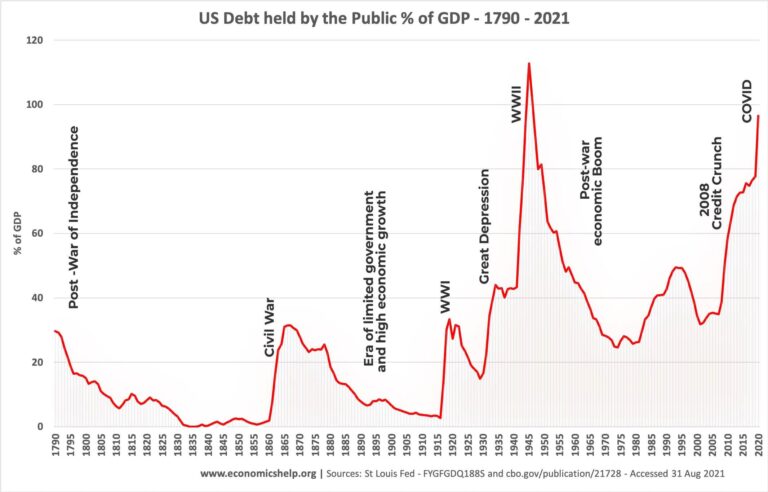Understanding the Market Valuation of U.S. Government Debt: Insights and Implications
Recent Shifts in U.S. Government Debt Market Value and Their Broader Economic Impact
The valuation of U.S. government debt in the market has experienced notable changes influenced by varying interest rates, investor confidence, and shifts in economic policy. While the nominal amount of outstanding debt steadily rises, its market value fluctuates more dynamically, reflecting the current interest rate environment. For example, when interest rates climb, the market price of existing fixed-coupon bonds generally declines, impacting both portfolio valuations and the government’s cost of borrowing. These movements highlight the intricate relationship between fiscal strategies and the Federal Reserve‚Äôs monetary policies.
Economic consequences stemming from these market value variations include:
- Alterations in the government’s borrowing capacity and perceived creditworthiness.
- Changes in projected interest expenses, influencing budgetary constraints.
- Investor signals regarding inflation expectations and the overall economic growth forecast.
| Year | Nominal Debt (Trillions $) | Market Valuation (Trillions $) | Average Interest Rate (%) |
|---|---|---|---|
| 2021 | 28.4 | 27.1 | 1.25 |
| 2022 | 30.0 | 26.5 | 2.75 |
| 2023 | 31.8 | 25.9 | 4.00 |
Insights from the Federal Reserve Bank of Dallas on Debt Market Volatility
The Federal Reserve Bank of Dallas recently conducted a comprehensive review of the volatility observed in the U.S. government debt market. Their findings attribute much of the price variability to macroeconomic influences such as inflation outlooks, adjustments in interest rates, and geopolitical tensions. The report emphasizes the nuanced interaction between government fiscal policies and market perceptions, which collectively determine the pricing of Treasury securities. Notably, changes in Treasury yields have led to diverse demand responses across different maturities, affecting both short-term and long-term instruments.
Highlights from the Dallas Fed’s analysis include:
- Sensitivity to Interest Rate Changes: Long-duration debt instruments are particularly vulnerable to rate hikes, resulting in pronounced price fluctuations.
- Market Liquidity Concerns: Reduced liquidity during economic downturns can exacerbate price volatility.
- Investor Preferences: Heightened risk aversion during uncertain periods has driven a shift toward safer government assets.
| Debt Instrument | Yield Change (basis points) | Market Response |
|---|---|---|
| 3-Month Treasury Bill | +15 | Consistent Demand |
| 10-Year Treasury Note | +40 | Price Decline |
| 30-Year Treasury Bond | +50 | Elevated Volatility |
Evaluating Risks and Strategic Opportunities for Investors in U.S. Treasury Securities
For investors, navigating the U.S. government securities market requires a careful assessment of multiple factors that influence both risk and return. Interest rate movements remain a dominant force, as rising rates tend to reduce the market value of existing bonds, whereas declining rates generally boost prices. Additionally, inflation trends play a critical role in determining real yields, making Treasury Inflation-Protected Securities (TIPS) an essential tool for safeguarding purchasing power. Beyond economic indicators, geopolitical developments and fiscal policy shifts also significantly affect investor confidence and risk profiles.
Amid these challenges, investors can capitalize on opportunities by adopting thoughtful strategies such as:
- Spreading investments across various maturities to optimize liquidity and returns.
- Closely tracking Treasury auctions and secondary market trends for timely decisions.
- Implementing laddering techniques to reduce reinvestment risk.
- Including a mix of government-backed securities with different sensitivities to interest rate changes.
| Security Category | Usual Maturity Range | Interest Rate Sensitivity |
|---|---|---|
| Treasury Bills (T-Bills) | 1 month to 1 year | Low |
| Treasury Notes (T-Notes) | 2 to 10 years | Moderate |
| Treasury Bonds (T-Bonds) | 20 to 30 years | High |
| TIPS | 5 to 30 years | Low to Moderate |
Strategic Policy Approaches for Federal Debt Management Amid Market Uncertainty
Managing the federal debt effectively during times of market instability demands a comprehensive approach aimed at preserving investor trust and minimizing refinancing risks. Central to this strategy is maintaining a well-diversified debt portfolio that balances short-term and long-term instruments to cushion against interest rate volatility. Furthermore, transparent and consistent communication with market participants is vital to reduce uncertainty and sustain demand for government securities during turbulent periods.
Additional policy recommendations include:
- Proactive debt issuance planning: Scheduling debt sales in alignment with anticipated market conditions to lower borrowing expenses.
- Fiscal responsibility: Crafting budgets focused on sustainable economic growth to strengthen credit ratings.
- Enhanced transparency: Regularly releasing detailed debt statistics and market analyses to build investor confidence.
| Policy Focus | Goal | Anticipated Result |
|---|---|---|
| Diversified Debt Structure | Reduce exposure to interest rate fluctuations | Lower refinancing costs |
| Fiscal Discipline | Manage deficit growth | Improved sovereign credit ratings |
| Market Engagement | Increase transparency | Heightened investor trust |
Final Thoughts
In conclusion, the Federal Reserve Bank of Dallas offers valuable perspectives on the evolving market valuation of U.S. government debt, emphasizing key trends and their wider economic significance. As fiscal policies and market conditions continue to evolve, ongoing vigilance in tracking these valuations is crucial for investors, policymakers, and analysts. Staying well-informed enables a deeper understanding of the nation’s fiscal health and guides effective debt management strategies moving forward.







